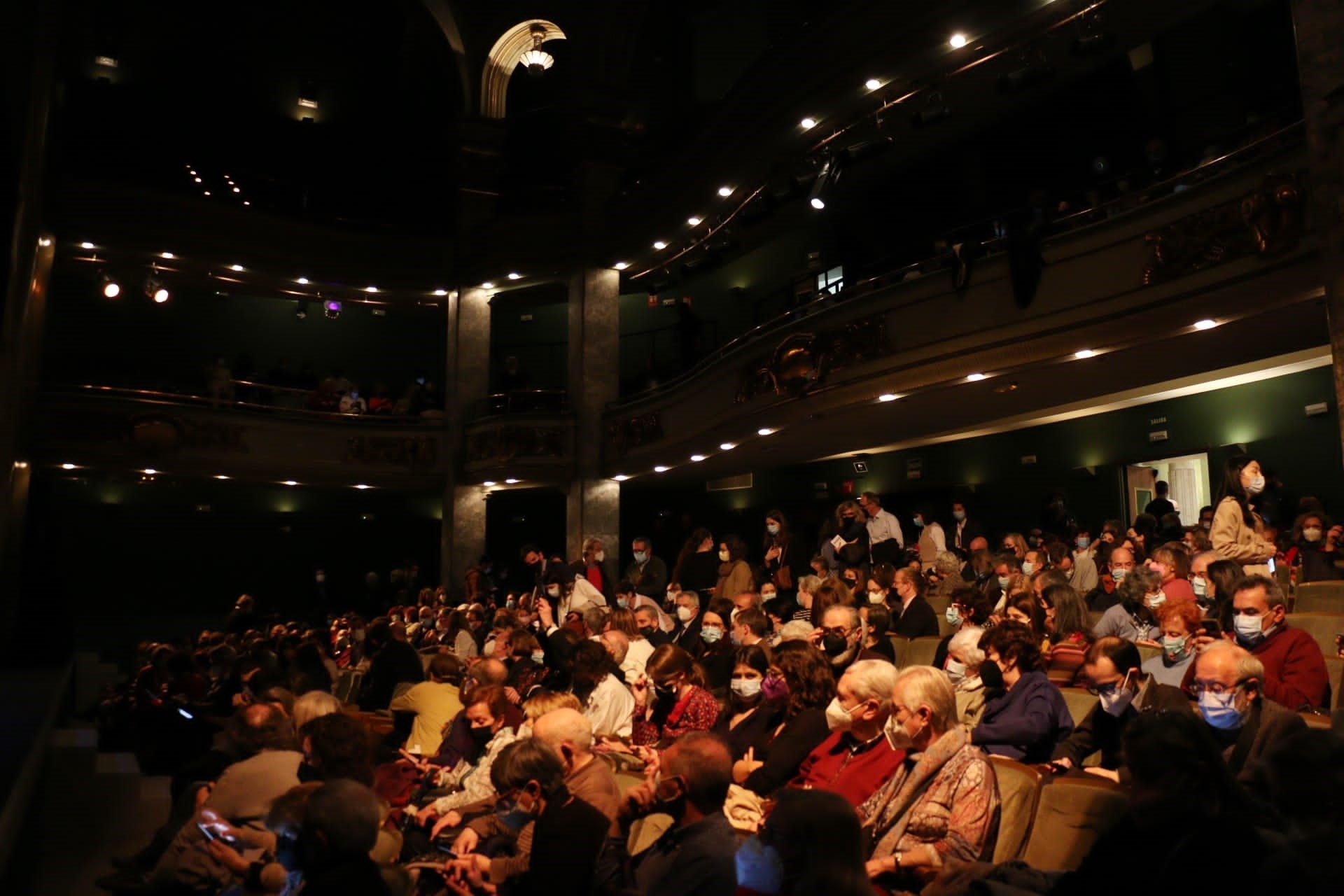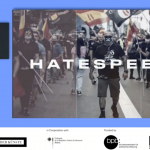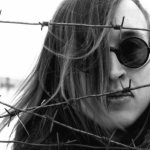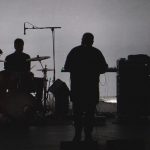Anastasiia Pestinova
El 31 de marzo se celebró un concierto de música clásica que reunió a músicos de diferentes nacionalidades que interpretaron un amplio abanico de composiciones, desde los clásicos hasta la modernidad. La primera impresión del evento fue la cantidad de gente que acudió, mucha y de diferentes edades, que ascendió por las escaleras de mármol para entrar en el teatro de cámara de tres pisos con una corona dorada en el techo. Un escenario con un gran piano de cola de color negro brillante estaba iluminado en azul intenso. La gente hablaba en diferentes idiomas, principalmente en español, pero también se oía el inglés y el alemán.
Cuando sonó la última campana, las luces se apagaron y en la escena entró la primera pareja de artistas para tocar la Passacaglia para violín y viola publicada por el compositor noruego J. Halvorsen y basada en el movimiento final de la suite para clave en sol menor del compositor alemán G. F. Haendel: un diálogo breve pero intenso de dos maestros. La siguiente artista que apareció era bastante extraordinaria y se diferenciaba de las demás por la edad pero no por el talento: una chica refugiada de Kiev. Vestida con una larga falda negra y una blusa blanca, y con el pelo largo, parecía un ángel, tal vez un angelus novus, un ángel de la historia que surge de las ruinas.
A continuación, un dúo de dos artistas presentó composiciones ucranianas inspiradas en el folclore y combinadas con la poesía de Ivan Franko y Taras Shevchenko, ambas figuras básicas para la identidad ucraniana y formativas para el lenguaje poético. La música de V. Silvestrov -compositor ucraniano aún vivo- apareció varias veces durante la velada. La primera parte del concierto finalizó con un instrumentista peruano que tocó el bandoneón, un instrumento que pertenece a una clase de cajas de presión entre las que se encuentra también el acordeón o el bayán y que tiene una técnica fascinante de tocar que produce un sonido estridente.
La segunda parte presentó al público algunas figuras nuevas: la pianista rusa A. Fedorova, que interpretó obras de Tchaikovsky, Chopin, Rachmaninov; la violinista bielorrusa con las obras de Reinhold Glière, compositor soviético nacido en Kiev. Conmovedora y profunda fue la “Oración” de M. Kugel presentada por el pianista ucraniano y el violista neerlandés, una rigurosa composición religiosa cercana a una especie de confesión. El concierto terminó con la nota alta de la voz de soprano de Tatiana Melnychenko, de Odesa, que presentó obras clásicas de los compositores italianos G. Caccini y G. Verdi: el poderoso “Ave María” y “La fuerza del destino”.
La ley básica de la música es la armonía como combinación más expresiva de las vibraciones acústicas para el oído, y como equilibrio dimensional del conjunto de voces, temas y partes individuales. Cada conflicto es una violación de la armonía social, una violación del balance y el equilibrio de las fuerzas internacionales, no un conjunto, sino un traqueteo, furioso e incapaz de restaurar la sinfonía de la coexistencia pacífica. Los eventos musicales durante los conflictos son a menudo el primer trago de la tan esperada paz, una especie de semilla cultural para la cristalización inicial de la armonía, un punto de partida y crecimiento de una voluntad consciente del mundo, un lugar donde las voces de los diferentes pueblos suenan juntas, llamando al menos a seguir escuchando los sonidos del mundo a través del rugido del conflicto.
Hoy en día necesitamos eventos como este donde la gente pueda reunirse y hacer algo juntos, un lugar donde los rusos no sean perseguidos y los ucranianos sean aceptados en su tragedia. Sin estos lugares no habrá posibilidad de diálogo y perspectivas constructivas. Quizá nada funcione tan profundamente con las experiencias traumáticas como el arte. Y si el pasado no puede ser totalmente redimido por él, entonces tal vez al menos parcialmente curado. Este tipo de iniciativas están construyendo las bases para un nuevo mundo que viene.
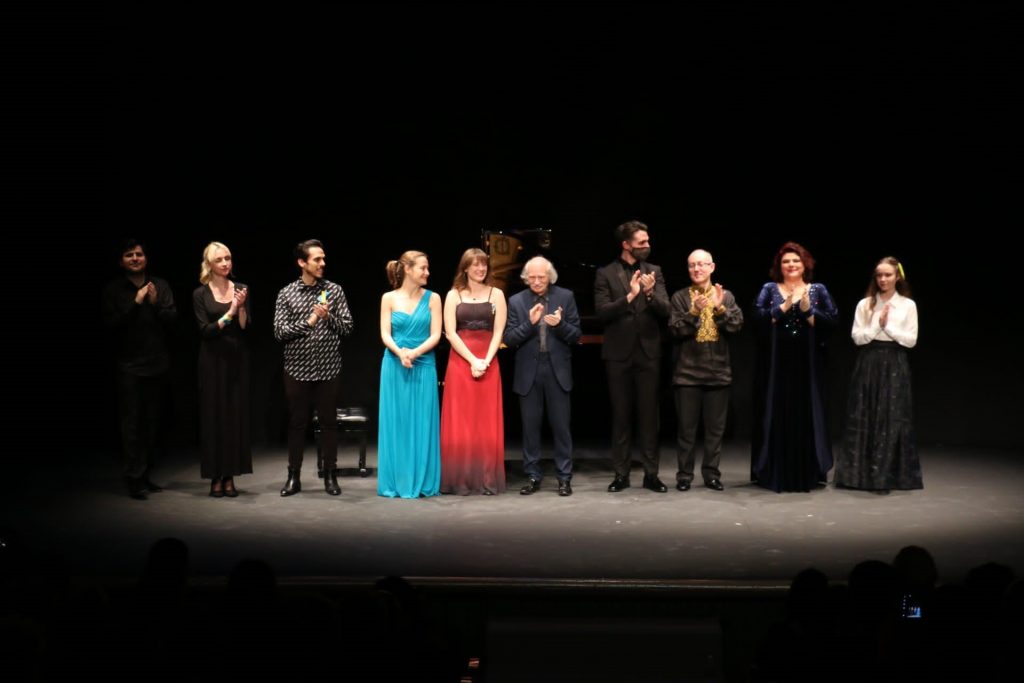
Самым первым впечатлением от мероприятия стало количество пришедших – множество людей разных возрастов поднимались по мраморным лестницам, чтобы зайти в камерный трёхъярусный театр с золотым венцом на потолке. Сцена с большим блестяще-черным роялем была освещена темно-синим светом. Люди говорили на разных языках, преимущественно на испанском, но слышались также английский и немецкий.
Когда раздался последний звонок и погас свет, на сцену вышла первая пара артистов, исполнявших Пассакалью для скрипки и альта, изданную норвежским композитором Ю. Хальворсеном и основанную на финальной части из сюиты немецкого композитора Г. Ф. Генделя — короткий, но насыщенный диалог двух исполнителей. Появившаяся следом пианистка производила необычное впечатление, отличаясь от остальных исполнителей возрастом, но не талантом – девочка беженка из Киева. Одетая в длинную черную юбку, белую блузку и с длинными волосами, она казалась ангелом, может быть, angelus novus, ангелом истории, восставшим из руин.
Затем последовал дуэт двух музыкантов, представивших композиции, вдохновленные украинским фольклором и соединенные с поэзией Ивана Франко и Тараса Шевченко – двух важных фигур для украинской идентичности, сформировавших поэтический язык. В течение вечера несколько раз звучала музыка В. Сильвестрова – современного украинского композитора. Первая часть концерта завершилась игрой перуанского инструменталиста на бандонеоне, инструменте, относящемся к классу гармоник, к которым так же относятся аккордеон и баян, обладающем завораживающей техникой игры, и производящем довольно пронзительный звук.
Во второй части концерта появились новые фигуры: российская пианистка А. Федорова, исполняющая произведения Чайковского, Шопена и Рахманинова; скрипачка из Белоруссии с произведениями Рейнгольда Глиэра, советского композитора, родившегося в Киеве. Трогательной и глубокой была «Молитва» М. Кугеля в исполнении украинского пианиста и альтистки из Голландии – строгое религиозное сочинение, близкое к своеобразной исповеди. Концерт завершился на высокой ноте сопрано Татьяны Мельниченко из Одессы, представившей классические произведения итальянских композиторов Дж. Каччини и Дж. Верди: сильные «Аве Мария» и «Сила судьбы».
Основой музыки является гармония, и как наиболее благозвучное для уха сочетание акустических вибраций, и как соразмерная уравновешенность ансамбля голосов, отдельных тем и частей. Конфликты представляют из себя нарушение социальной гармонии, баланса и равновесия международных сил, не ансамбль, а скрежет, яростный и не содержащий в самом себе возможность восстановить симфонию мирного сосуществования. Музыкальные события во время конфликтов зачастую являются первой весточкой долгожданного мира, культурным зерном для начальной кристаллизации гармонии, точкой отсчёта и роста осознанной воли к миру, местом, где голоса разных народов звучат вместе, призывая как минимум продолжать вслушиваться в звуки мира сквозь грохот боевых действий.
Сегодня как никогда нужны такие мероприятия, где люди могут встречаться и что-то делать вместе, где россиян не будут преследовать, а украинцев будут принимать в их трагедии. Без таких событий не будет возможности для диалога и конструктивных перспектив. Наверное ничто не работает так глубоко с травматическим опытом как искусство. И если прошлое не может быть полностью искуплено им, то, возможно, хотя бы частично залечено. Такие события закладывают основу для грядущего мира.
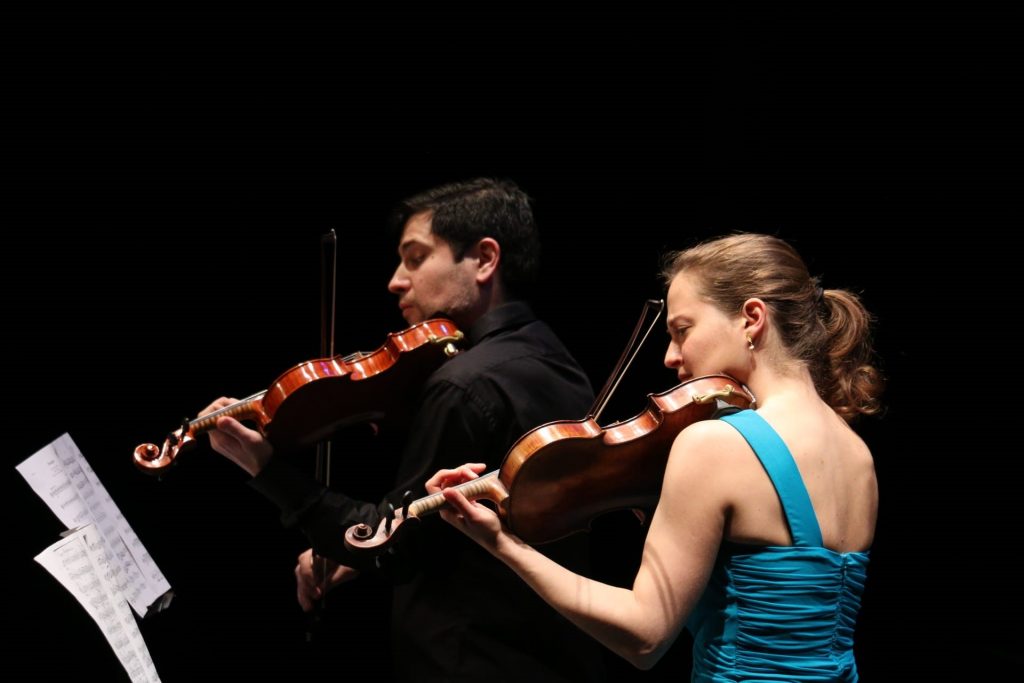
March 31st was held a concert of classical music that united musicians of different nationalities performing a wide range of compositions from classics to modernity. The very first impression of the event was the number of people who came – a lot and of different ages, all ascending the marble stairs to enter the chamber three-tiered theatre with a golden crown on the ceiling. A stage with a large, brilliantly black grand piano was illuminated in deep blue. People spoke different languages, mainly Spanish, but English and German were also heard.
When the last bell rang, the lights went out and at the scene entered the first pair of artists to play Passacaglia for a violin and viola published by Norwegian composer J. Halvorsen and based on the finale movement from the harpsichord suite in G minor by German composer G. F. Handel – a short but intense dialog of two master players. The next artist who appeared was quite extraordinary and differed from the others by age but not by talent – a refugee girl from Kiev. Dressed in a long black skirt with a white blouse and long hair she seemed an angel, maybe angelus novus, an angel of history rising from the ruins.
Then came a duet of two artists that presented Ukrainian compositions inspired by folklore and combined with poetry of Ivan Franko and Taras Shevchenko – both basic figures for Ukrainian identity and formative for poetic language. Music of V. Silvestrov – still alive Ukrainian composer – appeared several times during the evening. The first part of the concert ended with Peruvian instrumentalist playing bandoneón, an instrument that belongs to a class of squeeze-boxes among which stands also accordion or bayan and has fascinating technique of playing that produces strident sound.
Second part introduced to the audience some new figures: Russian piano player A. Fedorova doing the works of Tchaikovsky, Chopin, Rachmaninov; Belorussian Violinist with the works of Reinhold Glière, soviet composer born in Kiev. Touching and profound was a «Pray» of M. Kugel presented by Ukrainian pianist and Netherlandish violist – rigorous religious composition close to a kind of confession. The concert was finished on the high note of soprano voice of Tatiana Melnychenko from Odessa who presented classic works of Italian composers G.Caccini and G.Verdi: powerful «Ave Maria» and «The force of the destiny».
The basic law of music is harmony as the most expressive combination of acoustic vibrations for the ear, and as a dimensional balance of the ensemble of voices, individual themes and parts. Each conflict is a violation of social harmony, violation of the balance and equilibrium of international forces, not an ensemble, but a rattle, furious and incapable of restoring the symphony of peaceful coexistence. Musical events during conflicts are often the first swallow of the long-awaited peace, a kind of cultural seed for the initial crystallization of harmony, a starting point and growth of a conscious will to the world, a place where the voices of different people sound together, calling at least to continue to listen to the sounds of the world through the roar of conflict. Nowadays we need the events like this where people can meet and do something together, place where Russians won’t be chased and Ukrainians will be accepted in their tragedy. Without such places there will be no possibility for dialogue and constructive perspectives. Perhaps nothing works as deeply with traumatic experiences as art. And if the past cannot be wholly redeemed by it, then maybe at least partially healed. Such initiatives are building the bases for a new world upcoming.
Imágenes: Miguel Balbuena

